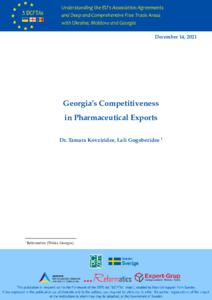
Georgia’s competitiveness in pharmaceutical exports
This paper is aimed at exploring Georgia’s potential in pharmaceutical production and export to the EU as well as to other countries. More specifically, it focuses on the analysis of production and export of medicines of the product group HS 3004.
This product group includes medicines consisting of mixed or unmixed products for therapeutic or prophylactic uses, put up in measured doses or in forms or packaging for retail sale, i.e. so-called packaged medicines. The main reason for choosing pharmaceuticals of the product group HS 3004 is to explore Georgia’s potential of production and respectively export of final products (packaged medicines) for retail sale and not semi-processed ones (such as medicines of the HS 3003 product group) or substances.
The analysis covers a period of 2012-2019 as disaggregated data is available for this period. Production and trade trends of the past eight years give a fairly good picture of the situation on the global, EU and Georgian markets. The analysis does not cover 2020, considering that this year was characterised by unusual circumstances and the COVID-19 pandemic caused substantial changes in the pharmaceutical market, including in terms of export and import of medicines. The analysis is based on statistical information available at the International Trade Centre and specifically the Trade Map.
Analysis of Georgia’s production and export potential is relevant because Georgia, having free trade agreements (FTAs) with markets of 2.3 billion population including the EU, Turkey, CIS countries, EFTA, China and Hong Kong, has opportunities to attract foreign direct investment (FDI) in the pharmaceutical sector, which would increase production and exports.
The Deep and Comprehensive Free Trade Area agreement (DCFTA) with the EU, together with other benefits, provides Georgia a unique opportunity to increase economic growth and FDI, and diversify export products as well as export destinations. Production of pharmaceutical products and more specifically, medicines, is a sector that has been growing rapidly in the past years. Exports of these products has been equally growing. Due to the DCFTA Georgia has neither tariffs on exports to the EU nor quantitative restrictions. However, certain non-tariff barriers apply, such as requirements for rules of origin and specific requirements for registration of medicines.
The EU is the global leader in the export of medicines. Among the top 10 global exporters of medicines (HS 3004), exporting over 67% of the total worldwide exported value (during 2012-2019 and in 2019), 9 countries are EU member states (EU 28), plus the USA with a share of over 6%. India is the next large exporter with over 3% share during the same period. China’s share in global export of this product was around 1% in 2012-2019 and 0.2% in 2019.
The pharmaceutical industry is rapidly growing and global demand increases. Over the last 5 years (2014-2019) the global turnover in pharmaceutical products (HS 30) increased by about 20%. The top 10 largest pharmaceutical companies, accounting for about a third of the global pharmaceutical market (with a value of over US$1 trillion), are mostly Europe- and USA- based companies, generating in total a revenue worth of US$ 392.5 billion in 2019.
The pharmaceutical sector has been one of the most attractive segments for investors, especially in the light of the COVID-19 pandemic, when this industry witnessed strong growth. According to a PwC assessment, due to rising demand for medicines, the global pharmaceutical market could reach nearly $1.6 trillion by 2020. During 2015-2019, the compound annual growth rate of the pharma market amounted to 6.7%.